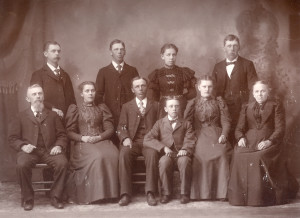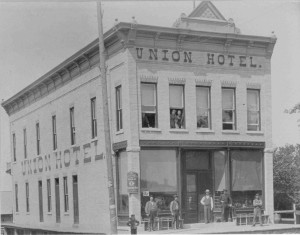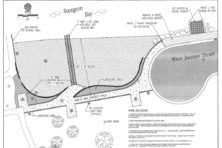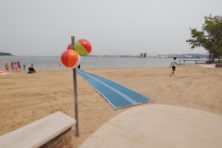Six Storied History: The Otumba
- Share
- Tweet
- Pin
- Share
What if a multi-story, luxury hotel was built in downtown Sturgeon Bay? How would Sturgeon Bay and the peninsula be different?
A six-story, 100-room luxury resort just feet from the Sturgeon Bay Shipping Canal – this was in the cards for Door County in 1929. Come 1930, the stock market crash laid waste to these designs, and effectively changed the plans and hopes of Sturgeon Bay.

Photo courtesy of the Door County Historical Museum.
It all started as the Union Hotel, a building that stood at the corner of Third Avenue and Jefferson Street, streets once called Cedar and Garland.
“The Union Hotel was at the corner of Third Avenue and Jefferson. It was on the side of Third closer to the bay,” said Door County Historical Museum assistant curator Ginny Haen. “Basically it’s a parking lot now.”
The first mention of the property was in the “Around the County” section of the June 9, 1894, Door County Advocate. The column said: “Marcus Moeller has purchased the Mullen place in the city, and he contemplates erecting a business block on the corner immediately. The property is located on Cedar Street and was formerly owned by D.A. Reed.”
Marcus bought the property from Dr. Mullen for $2,000, and transformed the building into a two-story hotel made of brick and stone. In 1899, Marcus died in his sleep at 53 years old after working a full day at the hotel. The June 10, 1899, obituary from the Door County Democrat said, “He has hewn out of the wilderness several large farms and built the Union Hotel, the finest property of the kind in the city.”
After Marcus’ death, the hotel stayed in the family and was taken over by his son William, who was working as the Sevastopol postmaster.
William was considered “one of the valued and most highly esteemed citizens of Sturgeon Bay,” according to Hjalmar Rued Holand in History of Door County, Wisconsin, the County Beautiful, Volume 2. Holand continued to say that while William was alive the Union Hotel was “a popular and well patronized hostelry.”
William like his father before him died relatively young at 44 years old on August 23, 1923. The hotel this time went not into the hands of a male relative, but to his wife, Mary (Propsom) Moeller.

The Moeller family. Submitted photo.
Holand wrote of Mary, “Since her husband’s death she has conducted the Union Hotel…She possesses excellent business ability and enjoys the goodwill and the respect of all who know her.”
After Mary ran the hotel for a few years, its ownership becomes a little scattered beginning in the 1920s. The confusion is noted in this excerpt from the June 23, 1922, issue of the Door County Advocate: “Mrs. Mary Moeller has again taken charge of the Union Hotel, having purchased it from George Paul. Last year she sold to Arnold N. Wagner, who later sold it to Max Pfeil. The hotel changed hands this spring when it was purchased by George Paul and now has been sold to original owner,” meaning Mary.
The most interesting aspect of the hotel’s history to Haen was “how many times it changed hands,” and how the ownership went in and out of the family.
The Moeller family has especial interest to Haen, as she married into it. “My husband’s great-grandpa, Marcus Moeller, was the man who started the Union, so that kind of makes it super interesting,” she added.
The hotel was passed back and forth between owners, and this pattern continued until after Mary gave over ownership to Mr. and Mrs. George Larscheid of Green Bay on January 1, 1927. The Larscheids renamed the hotel after their daughter – the Hotel Carmen. In yet another quick change of ownership, Mr. & Mrs. Harry R. Jones of Minneapolis bought the hotel on March 15, 1928, from the Larscheids.

William and Mary Moeller’s wedding photo. Submitted photo.
This is when the storied, short history of Hotel Otumba really begins.
The Joneses of Minneapolis had grand plans for the hotel, which they proposed to rename Hotel Otumba. These plans included adding four stories onto the Carmen – for a total of six stories with 86 rooms and suites, including a barbershop, tailor shop and beauty parlor in the basement of the hotel. There would also be a 150-capacity main dining room, coffee shop, rooftop garden and kitchen onsite.
“One of the finest hotels, if not the finest, in the state for a city of this size will be built here this coming winter and next spring on the site of the Hotel Carmen by the Harry R. Jones Hotel Company,” declared the October 18, 1929, issue of the Door County Advocate.
“The new structure, which has been designed by Charles Reynolds of Green Bay…will cost approximately $250,000.”
Construction was supposed to start in December of 1929, and be finished by June 15, 1930. In order for the towering building to be built, the City of Sturgeon Bay Board of Appeals even changed provisions of the zoning ordinance for the building to exceed the previous height limit of 60 feet.
The Joneses of Minneapolis had great plans for the hotel, and subsequently for Sturgeon Bay. It appears from various newspaper articles that Hotel Otumba was going to fill a void from a lack of accommodations. Apparently there was a need even in the late 1920s and early 1930s to draw visitors to the area.

Union Hotel. Submitted photo.
The October 1929 Advocate article continued, “The Hotel Otumba will offer all of the modern conveniences of a large city hotel so that tourists and traveling men will have the same accommodations here that they can get elsewhere. The huge roof garden, which will seat 400 at a banquet, will be ideal for the holding of conventions and result, without a doubt, in more conventions coming to Sturgeon Bay. In the past, many conventions have been lost here because of the insufficient accommodations.”
Haen thought this lack of accommodations peculiar since downtown Sturgeon Bay seemed to have quite a few lodging establishments in the late ’20s and early ’30s. She found in a phone book from 1930 these hotels: National Hotel, Sturgeon Bay Hotel [the Nautical Inn], Hotel Roxanna [the clock tower], Hotel Swoboda [Associated Bank], Hotel Bhirdo, Hotel Bongle and Hotel Commodore [Leathem Smith].
“There were several hotels on the west side [Sawyer] too,” said Haen. “That sounds like a lot of hotels to me, but I guess they didn’t think so.”
Even the new name was perceived as a potential draw for visitors, “The name of the new hotel will be The Otumba taken from the first name ever given to the site of Sturgeon Bay. The name has an interesting Indian origin [the article doesn’t explain the origin], furnishing an appealing note very appropriate for a center so popular for tourists.”

Hotel Carmen. Photo courtesy of the Door County Historical Museum.
A later article in the January 3, 1930, issue of the Door County News, titled “A Field for Winter Sports,” shows similar hopes for the hotel and the boon it could be for the city.
The article reads, “Now that there is every assurance that the new Hotel Otumba will be a reality and the City of Sturgeon Bay furnished with hostelry accommodations for at least several hundred people, plans might well be laid for creating a winter pleasure resort here as well as a summer resort. Why not? Why should not Sturgeon Bay be to the world of winter sports in the middle west what the city of Quebec is to the east?
“It might be a good idea for the Chamber of Commerce or some other organization to give this matter a little thought.”
Maybe it was from desperation to draw people into the county during the start of the Depression, but the writer of this article (no byline was included) was placing a wealth of confidence – “every assurance” – in a project that never showed any signs of coming to fruition.
From these few articles it appears there were high expectations of what the hotel could do for Sturgeon Bay, but all of these plans, designs and expectations came to naught when the stock market crashed in 1929.

A composite image of the architect’s sketch and a photo of where it would stand today. Photo by Len Villano.
According to the October 18, 1929, Advocate article, the Otumba would be financed by the sale of a $100,000 bond issue, $50,000 common stock and $100,000 preferred stock. The building was delayed due to higher than expected bids for construction costs and a very short window of time, only six months, to complete a building of that stature. A January 10, 1930, article from the Advocate read, “The delay in building will afford ample opportunity to iron out all of these problems. Mr. Jones states that without a doubt another year will see the new hotel a reality.”
Another year did not result in a successful construction. The hotel was passed, again, into the hands of the Larscheids, and remained in their ownership as Hotel Carmen into the 1960s.
Haen even has memories of the Carmen, “It was a hotel, but there were banquets there, too. I can remember being at a spelling bee there. Had I known my husband’s great-grandpa built it, I would have been more interested.”
The building was demolished in 1965 and, as Haen said, it is now a parking lot for the out-of-business Dollar General store.
Chalk it up to bad timing, but what if Hotel Otumba had been built in Sturgeon Bay? Sturgeon Bay, and Door County, would look different today. Not just with the presence of “one outstanding edifice in Sturgeon Bay,” but with other six-story buildings that would inevitably followed in the Otumba’s wake up and down the peninsula. It would have been spectacular to see the Sturgeon Bay Ship Canal from a rooftop garden, but maybe the dissolution of Hotel Otumba was an unknown blessing of history – it preserved the county from multi-story developments, and isn’t that a draw for contemporary visitors ?





